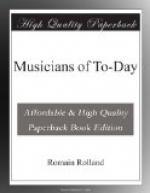I wanted at first to trace the broad line of the movement which for the last thirty years has been affecting French music; and now I shall consider the musical institutions that have had their share in this movement. You will not be surprised if I ignore some of the most celebrated, which have lost their interest in it, in order that I may consider those that are the true authors of our regeneration.
MUSICAL INSTITUTIONS BEFORE 1870
It is not by any means the oldest and most celebrated musical institutions which have taken the largest share in this evolution of music in the last thirty years.
The Academie des Beaux-Arts, where six chairs are reserved for the musical section, could have played a very important part in the musical organisation of France by the authority of its name, and by the many prizes that it gives for composition and criticism, especially by the Prix de Rome, which it awards every year. But it does not play its part well, partly because of the antiquated statutes that govern it, by which a handful of musicians are associated with a great number of painters, sculptors, and architects, who are ignorant of music and mock at the musicians, as they did in the time of Berlioz; and partly because it is the custom of the Academy that the little group of musicians shall be trained in a very conservative way. One of the names of these musicians is justly celebrated—that of M. Saint-Saens; but there are others whose fame is of poorer quality, and others still who have no fame at all. And the whole forms a little group, which though it does not put any actual obstacles in the way of the progress of art, yet does not look upon it favourably, but remains rather apart in an indifferent or even hostile spirit.
The Conservatoire national de Musique et de Declamation, which dates from the last years of the Ancien Regime and the Revolution, was designed by its patriotic and-democratic origin to serve the cause of national art and free progress.[210]
[Footnote 210: One knows that the Conservatoire originated in L’Ecole gratuite de musique de la garde nationale parisienne, founded in 1792 by Sarrette, and directed by Gossec. It was then a civic and military school, but, according to Chenier, was changed into the Institut national de musique on 8 November, 1793, and into the Conservatoire on 3 August, 1795. This Republican Conservatoire made it its business to keep in contact with the spirit of the country, and was directly opposed to the Opera, which was of monarchical origin. See M. Constant Pierre’s work Le Conservatoire national de musique (1900), and M. Julien Tiersot’s very interesting book Les Fetes et les Chants de la Revolution francaise (1908).]




